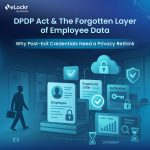India’s Digital Personal Data Protection Act (DPDPA), 2023 introduces a new discipline around how organisations collect, process, store, and delete personal data. Much of the conversation so far has focused on customer consent and digital transactions. Yet one critical area remains largely overlooked — what happens to personal data after an employee leaves an organisation. Experience letters, relieving details, tenure history, role information, payroll data, and background-verification artefacts all qualify as personal data under the Act. Ironically, this is the layer of information many organisations manage the least consistently.
DPDP forces a re-evaluation of this forgotten portion of the workforce data lifecycle. At its core, the Act establishes a rights-first framework based on specific consent, limited and purposeful data collection, secure processing, defined retention, and the individual’s right to access, correct, or delete their information. These obligations apply as much to former employees as they do to current ones. The moment an employee exits, the organisation’s responsibility toward their data does not disappear; it simply shifts into a new phase governed by purpose, consent, and retention discipline. This raises an important question: what post-exit data should continue to exist, and why?
For years, post-exit employee data has been a blind spot, not because of negligence, but because of inertia. Organisations often store past employee records across old emails, shared drives, HRMS exports, personal laptop folders, or outdated archives with no clear retention timeline. Over time, this creates an unstructured shadow ecosystem of sensitive data that persists unnoticed, often accessible to people who no longer require access. DPDP brings this reality to the surface. It insists on traceability: where the data lives, who interacts with it, how long it remains, and what rights individuals have over its lifecycle. The implications are especially significant for employment credentials. Experience letters and verification documents are frequently emailed, forwarded, and re-forwarded; each hop increasing the exposure and risk.
This is why the Act represents a turning point for alumni credentials and verification. Post-exit data is not merely administrative history. It influences background checks, future job transitions, higher education applications, global mobility processes, and even professional skill validation. Yet traditional credentialing systems were never designed with data protection in mind. Many organisations still issue documents manually, verify past employees through unstructured email exchanges, retain information indefinitely, operate without audit trails, and have no mechanism for consent governance. Under DPDP, these long-standing practices are no longer just inefficient, they become high-risk.
The Act compels organisations to rethink how they manage this workflow. Post-exit information must now be purpose-limited, securely stored, accessed only by authorised parties, and deleted once its purpose is fulfilled. Sharing needs to be consent-driven, and every touchpoint must be traceable. As a result, alumni verification transforms from a routine HR task into a privacy-sensitive process with regulatory expectations. DPDP does not prescribe specific tools for managing this shift, but it does enforce discipline. For ex-employee credentials, that discipline translates into reducing manual circulation of documents, eliminating uncontrolled email-based verification, building consent-aware access pathways, and ensuring that verifications depend on accurate and authorised sources rather than informal communication. It also means clearly defining retention timelines, maintaining auditability, and putting guardrails around how long ex-employee data is held.
A structured, privacy-aligned credentialing ecosystem protects not only organisations but also individuals who rely on past employment records while navigating new opportunities. When implemented well, it reduces the risks of identity misuse, document tampering, or unauthorised data sharing; vulnerabilities that have only intensified in the era of remote work, gig hiring, and global mobility.
This is where the true opportunity lies. DPDP is not simply a compliance mandate; it is an invitation to modernise how organisations manage the full lifecycle of employee data. Cleaner records, reduced operational overhead, fewer verification escalations, and stronger alumni relationships are just some of the benefits. More importantly, it strengthens the trust that organisations hold with employees long after their final working day.
In a world where career transitions are frequent and global, privacy-safe and instantly verifiable credentials are no longer a nice-to-have, they are becoming a competitive advantage. The DPDP Act marks a shift toward accountability and transparency in data handling, and while companies are rightly prioritising customer-facing compliance updates, the real test will be in how they manage the quieter, often ignored, long-tail layer of post-exit employee information.
Post-exit data is no longer a grey area. It is a regulated space that requires clarity, consent, and thoughtful stewardship. By recognising alumni credentials and ex-employee data as an essential part of the privacy ecosystem, organisations don’t just adhere to the law, they reinforce trust at every stage of the employee journey, even after it ends.





Leave a Reply